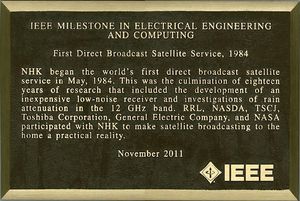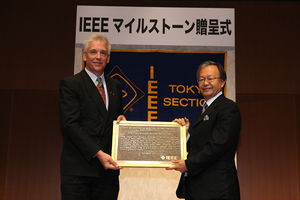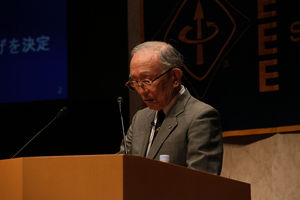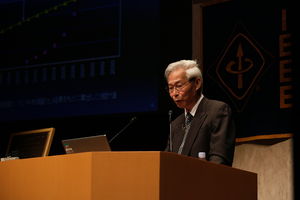Milestones:First Direct Broadcast Satellite Service, 1984
First Direct Broadcast Satellite Service, 1984
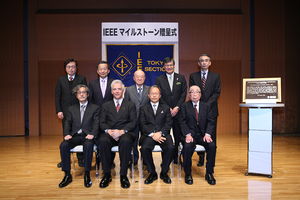
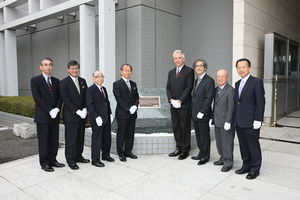
NHK began the world's first direct broadcast satellite service in May, 1984. This was the culmination of eighteen years of research that included the development of an inexpensive low-noise receiver and investigations of rain attenuation in the 12 GHz band. RRL, NASDA, TSCJ, Toshiba Corporation, General Electric Company, and NASA participated with NHK to make satellite broadcasting to the home a practical reality.
The milestone plaque may be viewed outside the building of NHK Science and Technology Research Laboratories, Setagaya-ku, Tokyo.
The research and development on satellite broadcasting technologies made it possible for all households in Japan, even those in remote areas, to receive television broadcasting services. It also laid the foundation for satellite broadcasting services that enable people all over the world today to receive news and entertainment programming.
NHK (Japan Broadcasting Corporation) laid out plans to use satellites for broadcasting in 1965, in response to the communication satellites being developed in the USA, and it began research and development on broadcasting satellites the following year.
One of the major achievements was the invention of a low-noise and inexpensive home receiver for the 12-GHz band. A low noise down-converter using a planer circuit mounted in a waveguide was invented in 1972, and it had a noise figure of 4.2 dB. At the time, most down-converters used a microstrip circuit and had noise figures of 6 to 12 dB.
The choice of the 12-GHz band for satellite broadcasting turned out to be a good one, because the rain attenuation in that band, as thoroughly measured by NHK, was not so severe. NHK’s research results were instrumental in building a broadcasting satellite of the same size and weight as a communications satellite.
An experimental broadcasting satellite was manufactured by Toshiba and GE, and it was launched in 1978 by NASA in the USA. NHK and other organizations conducted experiments on that satellite, and these developments led to the launch of the first practical broadcasting satellite by NASDA (National Space Development Agency) of Japan in January 1984. Broadcasting to the public began in May. This was the first satellite broadcasting to provide high-quality TV services to the general public in the world.
This work represented a significant advance in satellite transmission capabilities. Direct broadcasting from a satellite in geostationary orbit to inexpensive home receivers equipped with a small antenna was not the usual form of satellite communication at that time, which was between large-scale ground stations equipped with very large antennas and very expensive receivers cooled with liquid helium. Thus, it is clear this work opened up the field of satellite transmission technologies to new applications.
The satellite broadcasting had many good features in comparison with terrestrial broadcasting. It covered a very large area. The reception area included not only the main islands of Japan but also remote islands in the Pacific Ocean 500 km to 1,000 km away from the nearest terrestrial broadcasting stations.
It provided clear and beautiful TV pictures with PCM sound. The pictures were free of any ghost images from signals reflected off buildings and mountains. The signal could be received even behind tall buildings and high mountains. Moreover, it provided more TV channels than terrestrial TV broadcasting at the time could provide, and it was a platform to develop and provide new broadcasting services such as HDTV (High Definition Television).
References and Further Reading
A) Research and development at NHK that laid the foundation of satellite broadcasting
A-(1) Y. Konishi et al., “Proposed SHF FM Receiver for Satellite Broadcasting,” IEEE -ICC 1973, No. 36-15, June 1973Media:A-(1).pdf
A-(2) Y. Konishi et al., “The Design of Planar Circuit Mounted in Waveguide and the Application to Low noise 12GHz Converter,” 1974 IEEE-S, MTT International Microwave SymposiumMedia:A-(2).pdf
A-(3) Y. Konishi et al., “The Design of a Bandpass Filter with Inductive Strip-Planar Circuit Mounted in Waveguide,” IEEE Transactions on MTT, Vol. MTT-22, pp 869-873, October 1974Media:A-(3).pdf
A-(4) Y.Konishi,et al., “Simplified 12-GHz Low-noise Converter with Mounted Planar Circuit in Waveguide,” IEEE Transactions on MTT, Vol.MTT-22, No.4, 1974Media:A-(4).pdf
A-(5) Y. Konishi et al., “12GHz-Band FM Receiver for Satellite Broadcasting,” SMPTE Journal, March 1980, Vol. 89, pp 162-166Media:A-(5).pdf
A-(6) M. Matsushita et al., “Study of Orbit/Frequency Utilization for Satellite Broadcasting (Part 1),” NHK Laboratories Note, Serial No. 143, May 1971[[Media:A-(6)Media:A-(6).pdf
A-(7) M. Matsushita et al., “Study of Frequency Sharing between Satellite and Terrestrial Broadcasting Systems,” Proc. of the 9th International Symposium on Space Technology and Science, Tokyo 1971Media:A-(7).pdf
A-(8) A. Kinase et al., “Statistics of Attenuation Due to Precipitation of Radio Waves in 12GHz Band at Higher Angles of Elevation,” NHK Laboratories Note, Serial No. 171Media:A-(8).pdf
B) Development of experimental broadcasting satellite and various experiments conducted using the satellite
B-(1) M. Hirai et al., “Development of a Medium-Scale Broadcasting Satellite for Experimental Purpose,” Proc. of the 11th International Symposium on Space Technology and Science, Tokyo 1975Media:B-(1).pdf
B-(2) A. Kawabayashi et al., “Design and Development of the Engineering Model TV Transponder for the Medium-Scale Broadcasting Satellite for Experimental Purpose,” Proc. of the 11th International Symposium on Space Technology and Science, Tokyo 1975Media:B-(2).pdf
B-(3) K. Tsukamoto et al., “Technical Aspects of the Japanese Broadcasting Satellite Experiments,” IEEE Transactions on Broadcasting, Vol. BC-24, No.4. December 1978Media:B-(3).pdf
B-(4) Y. Ichikawa et al., “The Japanese Medium-Scale Broadcasting Satellite for Experiment Purpose,” 11th International TV Symposium, Montreux, Swiss, May 1979Media:B-(4).pdf
B-(5) T. Ishida et al., “Present Situation of Japanese Broadcasting for Experimental Purpose,” IEEE Transactions on Broadcasting, Vol. BC-25, No. 4, December 1979Media:B-(5).pdf
B-(6) Y. Otsu et al., “Propagation Measurements and TV-Reception Tests with the Japanese Broadcasting Satellite for Experimental Purpose” IEEE Transactions on Broadcasting, Vol. BC-25, No. 4, December 1979Media:B-(6).pdf
B-(7) N. Imai et al., “Main Transmit and Receive Station in Japanese BSE Program,” 1980 IEEE MTT-S International Microwave Symposium Digest, May 1980, Washington, D.C.Media:B-(7).pdf
B-(8) Y. Konishi et al., “Performance Characteristics of a Transportable Transmit and Receive Station of A-Type for Japan’s Medium-Scale Broadcasting Satellite for Experimental Purpose,” 1980 IEEE MTT-S International Microwave Symposium Digest, May 1980, Washington, D.CMedia:B-(8).pdf
B-(9) H. Hayashida et al., “14/12 GHz Band Mobile-Type Earth Station for Japanese Broadcasting Satellite Communication,” 1980 IEEE MTT-S International Microwave Symposium Digest, May 1980, Washington, D.CMedia:B-(9).pdf
B-(10) M. Kajima et al., “Receive-Only Station for Broadcasting Satellite Experimental,” 1980 IEEE MTT-S International Microwave Symposium Digest, May 1980, Washington, D.CMedia:B-(10).pdf
B-(11) S. Shimizu, “Operational Achievements with Japanese Broadcasting Satellite for Experimental Purpose,” 1980 IEEE MTT-S International Microwave Symposium Digest, May 1980, Washington, D.CMedia:B-(11).pdf
B-(12) M. Yamamoto et al., ”Evaluation of Service Area in the Satellite Broadcasting by the BSE,” 1980 IEEE MTT-S International Microwave Symposium Digest, May 1980, Washington, D.CMedia:B-(12).pdf
B-(13) T. Ohtake et al., “Verification Testing of Japan’s Experimental Broadcast Satellite,” Proc. of the 13th International Symposium on Space Technology and Science, Tokyo 1982Media:B-(13).pdf
C) Development of the first practical broadcasting satellite
C-(1) S. Sonoda et al., ”BS-2 Spacecraft Design,” Proc. of the 13th International Symposium on Space Technology and Science, Tokyo 1982Media:C-(1).pdf
D) NHK honoured for direct broadcast satellite contributions
Letter from the site owner giving permission to place IEEE milestone plaque on the property.
Satellite Broadcasting Milestone Support Letter
Proposal and Nomination
Milestone-Proposal:The first satellite broadcasting to the public
Milestone-Nomination:The first satellite broadcasting to the public
